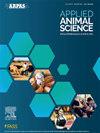Evaluation of Saccharomyces cerevisiae fermentation product on the prevention of digital dermatitis using an experimental infection model in cattle
IF 1.5
Q3 AGRICULTURE, DAIRY & ANIMAL SCIENCE
引用次数: 0
Abstract
Objective
The objective of this research was to evaluate the efficacy of a feed supplement, Saccharomyces cerevisiae fermentation product (SCFP, NutriTek, Diamond V, Cedar Rapids, IA), on the prevention of digital dermatitis (DD) lesions in Holstein Friesian steers. For this research, an experimental infection model was used to reliably induce DD lesions in cattle.
Materials and Methods
A blind completely randomized study was conducted using a digital dermatitis infection model. Following 7 d of hydropic skin maceration in a wrap, the hind feet of 49 Holstein Friesian steers (24 control and 25 SCFP) were inoculated with bovine DD lesion homogenate and remained wrapped until clinical signs of DD were observed or until the protocol endpoint. Pellets containing SCFP (12 g/d NutriTek) or control supplements were mixed in the steers’ respective daily total mixed ration and fed throughout the duration of the study.
Results and Discussion
Seven days after inoculation, all 49 steers developed an M1 (early focal bacterial keratolysis of the epidermis) or M2 (ulcerated/active) lesion on at least 1 hind foot. Treponeme species were detected by polymerase chain reaction, and invasive spirochetes were observed by histology in skin biopsies of the experimentally induced DD lesions. In this DD induction model, the relative risk of steers to develop M2 lesions in the control group was 1.53 (1.09–2.15, 95% CI) times greater than the SCFP group, although SCFP supplementation did not significantly affect the size of the M2 lesions. The multivariable regression analysis, adjusted for risk factors, confirmed that the control steers were significantly more likely to develop M2 lesions than the SCFP steers.
Implications and Applications
The DD experimental infection model used in the present study is useful for testing additional intervention strategies in cattle. The protective effect of SCFP against developing experimentally induced M2 DD lesions suggests that SCFP can be considered as a nutritional intervention to mitigate the risk of DD infection. Additional research is warranted to evaluate the potential mode of action to support the use of SCFP supplementation in the prevention of the development and transmission of DD lesions in cattle under field conditions.
用实验感染模型评价酿酒酵母发酵产物对牛数字性皮炎的预防作用
目的本研究的目的是评估一种饲料添加剂——酿酒酵母发酵产物(SCFP, NutriTek, Diamond V, Cedar Rapids, IA)对荷斯坦弗里西亚牛数字性皮炎(DD)病变的预防效果。在本研究中,采用实验感染模型可靠地诱导牛DD病变。材料与方法采用数字皮炎感染模型进行全随机盲法研究。在包裹7天后,将49头荷斯坦弗里西亚阉牛的后脚(24只对照和25只SCFP)接种牛DD病变匀浆,并保持包裹,直到观察到DD的临床症状或直到方案结束。在整个研究期间,将含有SCFP (12 g/d NutriTek)或对照补充剂的颗粒混合在犊牛的每日总混合日粮中。结果和讨论接种后7天,所有49头牛在至少1只后脚出现M1(表皮早期局灶性细菌性角化)或M2(溃疡/活动性)病变。采用聚合酶链反应检测密螺旋体种类,并在实验诱导的DD病变皮肤活检中观察到侵袭性螺旋体。在这个DD诱导模型中,对照组小鼠发生M2病变的相对风险是SCFP组的1.53倍(1.09-2.15,95% CI),尽管补充SCFP对M2病变的大小没有显著影响。多变量回归分析,调整了危险因素,证实对照者比SCFP者更容易发生M2病变。意义和应用本研究中使用的DD实验感染模型可用于测试牛的其他干预策略。SCFP对实验诱导的M2 DD病变的保护作用表明,SCFP可以被认为是一种营养干预,以减轻DD感染的风险。需要进一步的研究来评估潜在的作用模式,以支持使用SCFP补充剂来预防牛在野外条件下DD病变的发生和传播。
本文章由计算机程序翻译,如有差异,请以英文原文为准。
求助全文
约1分钟内获得全文
求助全文

 求助内容:
求助内容: 应助结果提醒方式:
应助结果提醒方式:


